English
Title: TOI-1338: TESS’ First Transiting Circumbinary Planet
Authors: Veselin B. Kostov, Jerome A. Orosz, Adina D. Feinstein, et al.
First Author’s Institution: NASA Goddard Space Flight Center + SETI Institute
Status: Published in AJ [closed access], available on arXiv
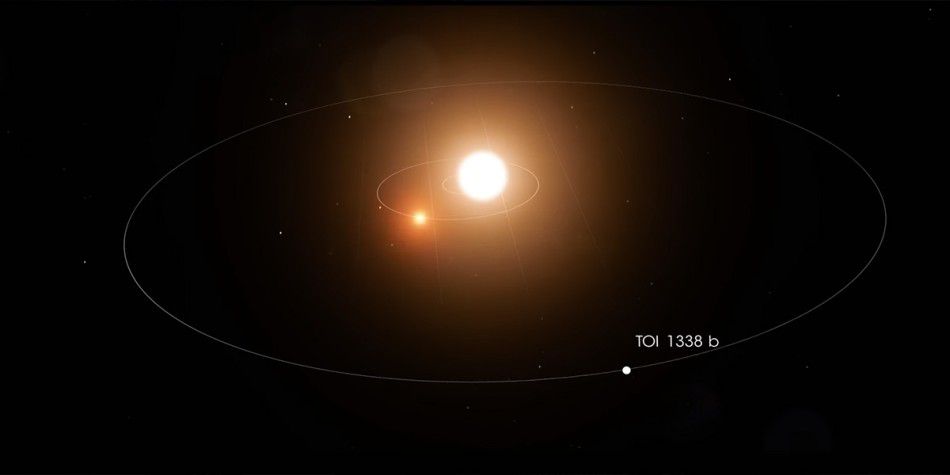
Source: nasa.gov
Two suns above the horizon. This iconic scene captured the imagination of millions in the very first Star Wars movie in 1977. It introduced us to Tatooine, home of Luke Skywalker and the origin of his great adventure to save the galaxy.
But for a long time, such a wild planetary system was considered to be pure fiction. At the time, nobody even knew if there are any planets at all beyond our own solar system. But a planet around a double star system? That’s a textbook three-body problem! Everything is tugged and pulled on by multiple and complex forces, so that the motion of the involved bodies is almost completely unpredictable, even if we know their exact location just an instant before. This implies a highly unstable orbit, with one of the bodies eventually shooting out into deep space, or crashing into one of the stars. No way the planet could be habitable, tumbling between freezing cold and rock-melting heat in its short and chaotic life.
Less than thirty years later, our preconceptions about planets and where they could form were finally and rapidly shaken to the core.
THE SEARCH FOR THE TWIN SUNSET
Shortly after the discovery of the first planet outside our solar system in 1992, the very first planet orbiting two stars, a circumbinary planet (CBP), was confirmed in 2000. It orbits around a pulsar and a white dwarf, two stellar corpses. Other surveys utilizing different methods have since been conducted, searching for CBPs.
With the launch of the Kepler mission in 2009, this category of planets was further expanded and diversified. The mission discovered, among others, a CBP within the habitable zone and even a planet located in a quadruple star system! In total, 11 binary star systems observed by Kepler turned out to host at least one planet.
Now, NASA’s TESS (Transiting Exoplanet Survey Satellite) mission is carrying on Kepler’s legacy as a broad transiting planet search effort, scanning the stars for an ever so slight drop in their flux, caused by a planet crossing the projected stellar surface.
THE HUNT GOES ON…
In early 2020, the first planet around a binary star system found by TESS was announced. This newly found planet (called TOI – 1338 b) is around the size of Saturn and finishes a lap around its two host stars in approximately 95 days (see Figure 1 for a schematic overview).
The stellar system itself has already been known before TESS was ever launched. It also goes by the catchy name EBLM J0608-59 and is an eclipsing binary system made up of a sun-like G star with 1.3 solar radii and a cooler M dwarf star with 0.3 solar radii.
Exoplanet researchers first became interested in TOI – 1338 after it caught the eye of a NASA intern, due to a temporary drop in flux within the light curves of the star (like the ones seen in Figure 2 in the upper panel, where there are multiple short drops coming from the secondary star), which was of similar depth to a ‘secondary eclipse’. During this event, the smaller star moves in front of the larger one and thus its contribution to the overall brightness of the system is blocked. But according to the calculations, it was happening at the wrong time. A second and third observation of this drop, shown in Figure 2, then confirmed it to be a real feature. It was also noted that the transit durations varied (~ 7.2 hours, ~ 14.4 hours and ~ 9.6 hours, respectively), which is a classic indication for CBPs. Usually, a transit by the same planet around a single star should last the exact same amount of time for each event, but because there are now two dynamic stars involved, the size of the bright surface the planet covers is dependent on the current position of the stars in their respective orbits.
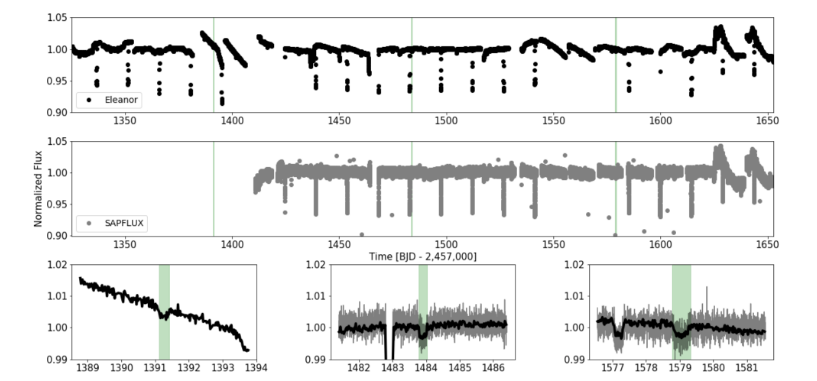
Source: Figure 1 in today’s paper
I DON’T LIKE SAND
To infer the planetary parameters (like radius, orbital period, etc.), the information provided by the TESS light curves and by spectroscopy, which measured the ‘wobble’ speed of the primary star, was evaluated. The smaller star’s presence causes the G star to travel at around 3.6 km/s around the common center of mass, while the stars orbit each other in roughly 15 days. The stellar masses being known, the planetary mass was constrained to 33.0 +/- 22.0 Earth masses. Technically, the planet causes an additional contribution to the radial velocity of the primary star, but it is too low to be picked up precisely by the instruments. Thus, the mass can only be roughly estimated. With a radius obtained from the transit depth of 6.85 +/- 0.19 Earth radii, the planet can be broadly classified as Saturn-like. So, this particular find most likely resembles a gas giant more than the deserts of Tatooine.
IS TOI – 1338 B ON A TIME LIMIT?
A CBP is not as orbitally stable as a planet located around a single star, due to the three-body problem, as briefly touched upon in the introduction. Studies suggest there is a critical period, below which planets around binary star systems become unstable and will eventually scatter onto an unbound orbit, sometimes colliding with one of the stars. Running sophisticated bayesian statistics, the authors show that the distances between the bodies in TOI – 1338 have been rather stable during the last 40,000 years. This is great news for the planet, indicating it will not be thrown out or swallowed any time soon.
Tatooine and the double shadows cast by its inhabitants still remains a great example of imaginative and beautiful story telling. Yet, although it is hard to say whether there is an exact duplicate of the Skywalker’s homeworld out there, we are confident today that a twin sunset is definitely not a purely fictional and outrageous idea anymore.
Astrobite edited by Katya Gozman and John Weaver
German
Titel: TOI-1338: TESS’ First Transiting Circumbinary Planet
Autoren: Veselin B. Kostov, Jerome A. Orosz, Adina D. Feinstein, et al.
Institut des Erstautors: NASA Goddard Space Flight Center + SETI Institute
Status: Veröffentlicht im AJ [closed access], verfügbar auf arXiv

Quelle: nasa.gov
Zwei Sonnen knapp oberhalb des Horizonts. Diese ikonische Szene fesselte damals die Fantasie von Millionen Zuschauern im allerersten Star Wars-Film von 1977. Sie führte uns nach Tatooine, der Heimat von Luke Skywalker und der Beginn seines großen Abenteuers, die Galaxie zu retten.
Doch lange Zeit galt ein solch wildes Planetensystem als reine Fiktion. Damals wusste noch niemand, ob es überhaupt Planeten jenseits unseres eigenen Sonnensystems gibt. Aber ein Planet um ein Doppelsternsystem? Das ist ein klassisches Drei-Körper-Problem! An allem zerrt und zieht eine Vielzahl komplexer Kräfte, so dass die Bewegung der beteiligten Körper fast völlig unvorhersehbar ist, selbst wenn wir ihre genaue Position nur einen Augenblick zuvor kennen. Dies impliziert eine höchst instabile Umlaufbahn, bei der einer der Körper schließlich in die Tiefen des Weltraums hinausschießt oder mit einem der Sterne zusammenstößt. Auf keinen Fall könnte der Planet bewohnbar sein, der in seinem kurzen und chaotischen Leben abwechselnd von eisiger Kälte und vulkanischer Hitze heimgesucht wird.
Kaum dreißig Jahre später wurden unsere Vorurteile über Planeten und deren mögliche Entstehung endgültig in ihren Grundfesten erschüttert.
DIE SUCHE NACH DEM ZWILLINGSSONNENUNTERGANG
Kurz nach der Entdeckung des ersten Planeten außerhalb unseres Sonnensystems im Jahr 1992 wurde 2000 der allererste Planet, der zwei Sterne umkreist (ein ‘circumbinary planet’ oder CBP), bestätigt. Er befindet sich im System eines Pulsars und eines Weißen Zwergs, zwei stellare Leichen. Seitdem wurden viele weitere Durchmusterungen mit unterschiedlichen Methoden durchgeführt, um nach CBPs zu suchen.
Mit dem Beginn der Kepler-Mission im Jahr 2009 wurde diese Kategorie von Planeten weiter ausgebaut und diversifiziert. Die Mission entdeckte u. a. einen CBP innerhalb der habitablen Zone und sogar einen Planeten in einem Vierfachsternsystem! Insgesamt stellte sich heraus, dass 11 Doppelsternsysteme, die Kepler beobachtete, mindestens einen Planeten beherbergen.
Jetzt führt die NASA-Mission TESS (Transiting Exoplanet Survey Satellite) das Erbe von Kepler als eine breit angelegte Suche nach sogenannten ‘transiting’ Planeten fort. Sie sucht die Sterne nach einem geringen Abfall ihrer Helligkeit ab, der durch einen Planeten verursacht wird, der die projizierte stellare Oberfläche durchquert.
DIE JAGD GEHT WEITER
Anfang 2020 wurde der erste von TESS gefundene Planet um ein Doppelsternsystem bekannt gegeben. Dieser neue Fund (genannt TOI – 1338 b) ist etwa so groß wie der Saturn und vollführt eine Runde um seine beiden Heimatsterne in etwa 95 Tagen (siehe Abbildung 1 für eine schematische Übersicht).
Das Sternsystem selbst war bereits bekannt, bevor TESS überhaupt gestartet wurde. Es ist ebenfalls unter dem klangvollen Namen EBLM J0608-59 bekannt und ist ein System von zwei Sternen, die von der Erde aus gesehen aneinander vorbei ziehen (man nennt das einen ‘eclipsing binary’). Es besteht aus einem sonnenähnlichen G-Stern mit 1,3 Sonnenradien und einem kühleren M-Zwergstern mit 0,3 Sonnenradien.
Exoplanetenforscher wurden erstmals aufmerksam auf TOI – 1338, nachdem es einem NASA-Praktikanten aufgefallen war. Er entdeckte vorübergehende Flussabfälle in den Lichtkurven des Sternensystems (wie in Abbildung 2 im oberen Feld zu sehen, wo es mehrere kurze Einbrüche gibt, die vom Sekundärstern ausgelöst werden), die einer “sekundären Bedeckung” ähneln. Während dieses Ereignisses bewegt sich der kleinere Stern vor dem größeren und somit wird sein Beitrag zur Gesamthelligkeit des Systems blockiert. Den Berechnungen zufolge geschah dies jedoch zum falschen Zeitpunkt. Eine zweite und dritte Beobachtung dieses Abfalls, die in Abbildung 2 dargestellt ist, bestätigte dann, dass es sich um ein echtes Feature handelt. Es wurde auch festgestellt, dass die Transitdauern variierten (~ 7,2 Stunden, ~ 14,4 Stunden bzw. ~ 9,6 Stunden), was ein klassisches Anzeichen für CBPs ist. Normalerweise sollte ein Transit desselben Planeten um einen einzelnen Stern bei jedem Ereignis genau gleich lange dauern, aber da nun zwei dynamische Sterne beteiligt sind, ist die Größe der hellen Fläche, die der Planet abdeckt, abhängig von der aktuellen Position der Sterne in ihren jeweiligen Bahnen.

Quelle: Abbildung 1 im heutigen paper
ICH MAG SAND NICHT…
Um auf die Planetenparameter (wie Radius, Umlaufzeit, etc.) zu schließen, wurden die Informationen der TESS-Lichtkurven und der Spektroskopie, die die “Wobble“-Geschwindigkeit des Primärsterns gemessen hat, ausgewertet. Die Anwesenheit des kleineren Sterns führt dazu, dass sich der G-Stern mit etwa 3,6 km/s um das gemeinsame Massenzentrum bewegt, während die Sterne einander in etwa 15 Tagen umkreisen. Da die Sternmassen bekannt sind, konnte die Planetenmasse auf 33,0 +/- 22,0 Erdmassen eingegrenzt werden. Theoretisch gesehen verursacht der Planet einen zusätzlichen Beitrag zur Radialgeschwindigkeit des Primärsterns, der aber zu gering ist, um von den Instrumenten genau erfasst zu werden. Daher kann die Masse nur grob abgeschätzt werden. Mit einem aus der Transittiefe ermittelten Radius von 6,85 +/- 0,19 Erdradien kann der Planet grob als Saturn-ähnlich eingestuft werden. Dieser besondere Fund ähnelt also wahrscheinlich eher einem Gasriesen als den Wüsten von Tatooine.
WIRD DIE ZEIT KNAPP FÜR TOI – 1338 B?
Ein CBP ist aufgrund des Dreikörperproblems, das in der Einleitung kurz angesprochen wurde, auf seiner Umlaufbahn nicht so stabil wie ein Planet, der um einen einzelnen Stern kreist. Studien deuten darauf hin, dass es eine kritische Umlaufperiode gibt, unterhalb derer Planeten um Doppelsternsysteme instabil werden und schließlich auf eine ungebundene Umlaufbahn gestreut werden und manchmal mit einem der Sterne kollidieren. Mit Hilfe ausgefeilter bayesianischer Statistik zeigen die Autoren, dass die Abstände zwischen den Körpern in TOI – 1338 während der letzten 40.000 Jahre ziemlich stabil waren. Dies ist eine gute Nachricht für den Planeten, die darauf hindeutet, dass er in nächster Zeit nicht herausgeschleudert oder verschluckt werden wird.
Tatooine und die doppelten Schatten, die seine Bewohner werfen, sind immer noch ein großartiges Beispiel für fantasievolle und wunderbare Geschichtenerzählung. Doch obwohl es schwer zu sagen ist, ob es ein exaktes Duplikat der Skywalker-Heimatwelt da draußen gibt, sind wir heute zuversichtlich, dass ein Zwillingssonnenuntergang definitiv keine rein fiktive und unerhörte Idee mehr ist.
Astrobite korrekturgelesen von Katya Gozman und John Weaver

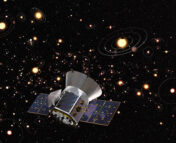

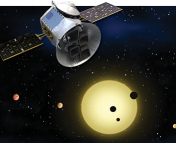
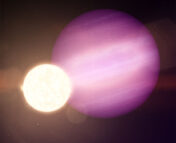
The NASA intern did look at TESS light curves that were tagged as “eclipsing binaries” by volunteers of the Planet Hunters Zooniverse project (see section 2.3 of the paper).
There is also this interesting interview of the NASA intern.
https://www.space.com/high-school-student-exoplanet-discovery-wolf-cukier.html?utm_source=feedburner&utm_medium=feed&utm_campaign=Feed%3A+spaceheadlines+%28SPACE.com+Headline+Feed%29
That’s true, the Planet Hunters project resulted in some really great and interesting discoveries, not only for CBPs but for example also for planets with long orbital periods that appear as single transits within the data.